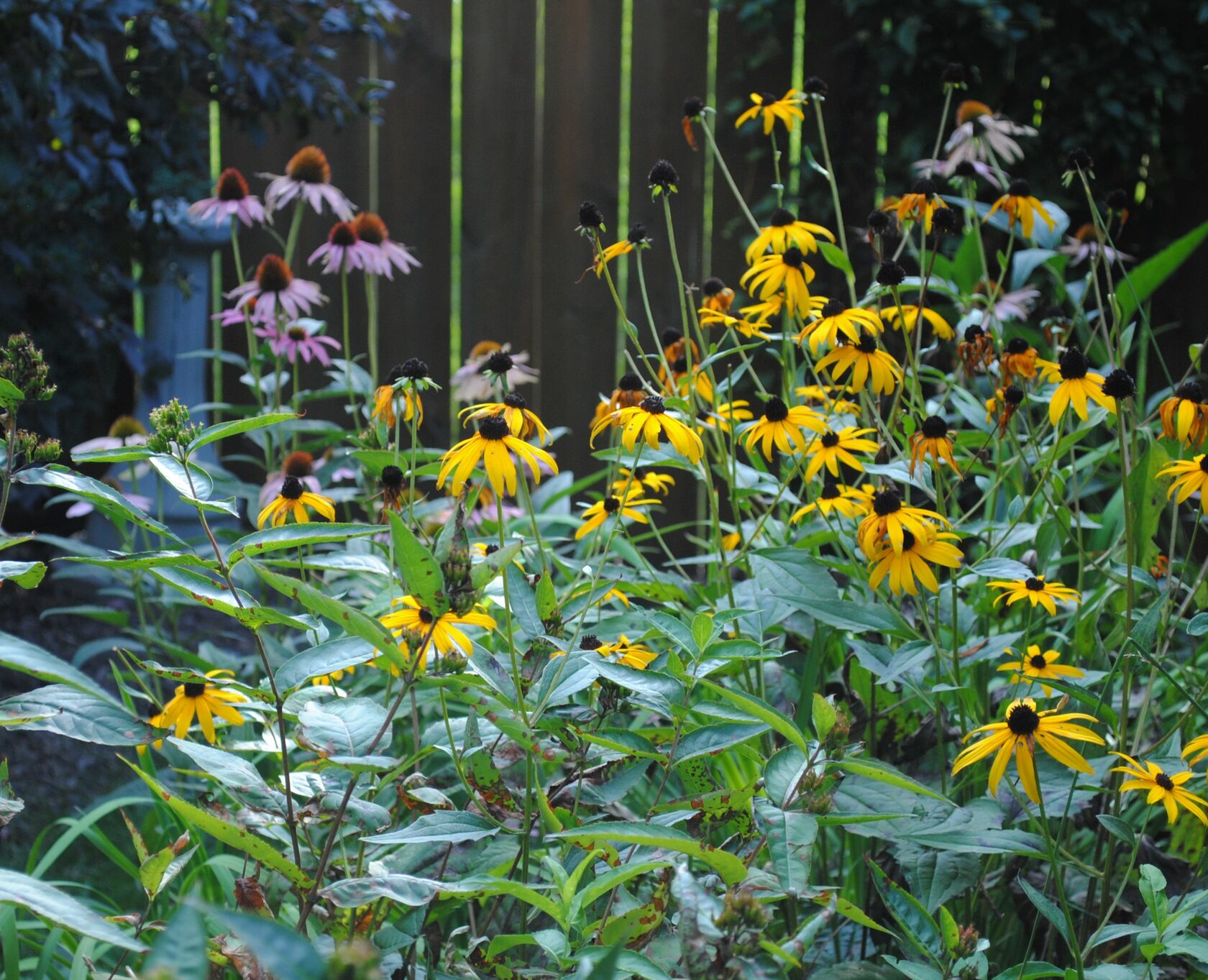You could be content to wait out your garden’s ‘dog days.’ Or scoop up a bunch of annual mums at your local garden center. But a more satisfying and long-lasting alternative is to plant a variety of perennials and grasses that bloom in the late summer and fall.
There are several great native and nativar selections that can keep your yard popping with color—all the way to the first frost. And many of these perennials are an important source of high-quality nectar for migrating wildlife like Monarch Butterflies.
Here are a few to consider, according to the Illinois Horticulture Extension:
- Black-eyed Susan (Rudbeckia Hirta)-- With its cheery yellow flowers, this is a favorite mainstay of the fall garden. It blooms August through October. Most varieties of Rudbeckia Hirta are biennials, meaning they will grow for only two seasons. However, they tend to reseed, so will meander a bit in your garden. I find them popping up in surprising places around our pond, which is always a welcome treat. Nativars to consider are ‘Goldsturm’ and ‘American Gold Rush,’ the latter which is more resistant to leaf spot.
- Purple Coneflower (Echinacea purpurea)—This is another last summer/fall ‘workhorse.’ Like Black-eyed Susan, it looks great planted in mass. Don’t cut back the plants once they’re blooms fade in late fall. The seed heads nourish goldfinches and other birds during the fall and winter. ‘Magnus’ is a nativar with similar characteristics but more vibrant color.
- Rough Blazing Star (Liatris aspera)—A great ‘spiky’ contrast to Black-eyed Susan and Purple Coneflower. Growing on single stalk from top to bottom, the plants bright purple flowers attract a variety of butterflies and bees. It blooms for approximately three weeks from later summer to early fall.
- Common Ironweed (Veronia fasciculata)--A great complement to taller back of the garden perennials like Goldenrod. While it can reach a height of four feet, Common Iron Weed rarely needs staking. Its dark purple flowers bloom from late summer to early fall. For a shorter, more compact nativar alternative, consider Vernonia lettermanii “Iron Butterfly.’
- New England Aster ( Symphyotrichum Nova-Angliae)—A long-standing classic in the fall garden. New England Aster has deep purple daisy-like flowers that can bloom up to two months in later summer/early autumn. The straight species, however, does present issues. It tends to flop and the lower plant leaves will turn brown and drop off during hot summers. That said, it is best to place the plants in the middle or back of the border. To avoid these issues and enjoy later blooms, you may want to plant ‘Purple Dome.’ It produces a dense mound of flowers in September and October. Pruning it back 30-50% in June will delay blooming and improve its shape.
- False Sunflower (Heliopsis helianthoides)—At four feet tall, this is a good back of the border plant. Its bright yellow flowers emerge in early summer and last two to three months. Deadheading will prolong blooming. And it will keep the plant from spreading if that is a concern.
- Goldenrod (Solidago spp.)—First let’s dispense with the myth. Goldenrod does not cause fall allergies. That comes courtesy of wind-pollinated Ragweed, a similar looking plant. Goldenrod can be a terrific addition to your fall garden. Just avoid varieties that spread aggressively like Canadian Goldenrod. Some good alternatives are Stiff Goldenrod, Zigzag Goldenrod (which can grow in partial shade) and Showy Goldenrod.
- Little Bluestem (Schizachyrium scoparium) —Fall is when native grasses really shine. One of the best known and beautiful is Little Bluestem. Its bluish-green leaves turn an attractive shade of orange in the fall. Spikes of deep purple flowers emerge above the foliage in late summer. And its dark red stems provide winter interest. The nativar ‘Carousel’ provides a different twist with a dense upright structure and reddish-purple fall color.
- Prairie Dropseed (Sporobolus heterolepis)— A very fine-textured grass that displays airy plumes of delicate seedheads in the fall. To keep taller plants from flopping over, plant grasses like Prairie Dropseed and River Oats In a matrix. A bonus feature of Prairie Dropseed is that it doesn’t matt down from snow. At one-half the height and spread of Prairie Dropseed, nativar ‘Tara’ is a good option for tighter spaces.
- Northern Sea Oats (Chasmanthium latifolium)--Also known as River Oats,this grass has pale green foliage that turns a coppery-bronze in the fall. While beautiful all season long, Northern Sea Oats’ drooping seed heads turn a purple-bronze color come autumn. Left alone, the seed heads provide added winter interest.
You don’t have to wait until next year to get these plants in the ground. With cooler temperatures and more ample rainfall, Fall is an ideal time for planting. If you water them consistently (deep soaking twice a week when there’s no rain), they should be well-established by the time winter rolls around.
